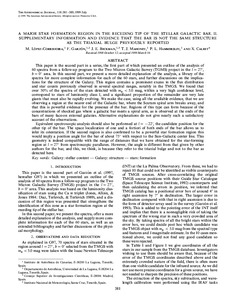Por favor, use este identificador para citar o enlazar este ítem:
http://hdl.handle.net/20.500.11765/14263
A major star formation region in the receding tip of the stellar galactic bar. II. Supplementary information and evidence that the bar is not the same structure as the triaxial bulge previously reported
| Título : | A major star formation region in the receding tip of the stellar galactic bar. II. Supplementary information and evidence that the bar is not the same structure as the triaxial bulge previously reported |
| Autor : | López Corredoira, Martín; Garzón, F.; Beckman, J. E.; Mahoney, Terence J.; Hammersley, P. L.; Calbet, Xavier



|
| Palabras clave : | Galaxy; Stellar content; Stars |
| Fecha de publicación : | 1999 |
| Editor: | IOP Publishing; American Astronomical Society |
| Citación : | Astronomical Journal. 1999, 118, p. 381-389 |
| Versión del editor: | https://doi.org/10.1086/300911 |
| Resumen : | This paper is the second part in a series, the Ðrst part of which presented an outline of the analysis of 60 spectra from a follow-up program to the Two Micron Galactic Survey (TGMS) project in the l\ 27¡, b \ 0¡ area. In this second part, we present a more detailed explanation of the analysis, a library of the spectra for more complete information for each of the 60 stars, and further discussions on the implications for the structure of the Galaxy. This region contains a prominent excess in the Ñux distribution and star counts previously observed in several spectral ranges, notably in the TMGS. We found that over 50% of the spectra of the stars detected with mag, within a very high conÐdence level, mK \ 5.0 correspond to stars of luminosity class I, and a signiÐcant proportion of the remainder are very late giants that must also be rapidly evolving. We make the case, using all the available evidence, that we are observing a region at the nearer end of the Galactic bar, where the Scutum spiral arm breaks away, and that this is powerful evidence for the presence of the bar. Regions of this type can form because of the concentrations of shocked gas where a galactic bar meets a spiral arm, as is observed at the ends of the bars of many face-on external galaxies. Alternative explanations do not give nearly such a satisfactory account of the observations. |
| Patrocinador: | This work was partially supported by grants PB94-1107 and PB97-0219 of the Spanish DGICYT. |
| URI : | http://hdl.handle.net/20.500.11765/14263 |
| ISSN : | 0004-6256 1538-3881 |
| Colecciones: | Artículos científicos 1995-1999 |
Ficheros en este ítem:
| Fichero | Descripción | Tamaño | Formato | ||
|---|---|---|---|---|---|
| AJ_Lopez_1999.pdf | 755,82 kB | Adobe PDF |  Visualizar/Abrir |
Los ítems de Arcimis están protegidos por una Licencia Creative Commons, salvo que se indique lo contrario.





